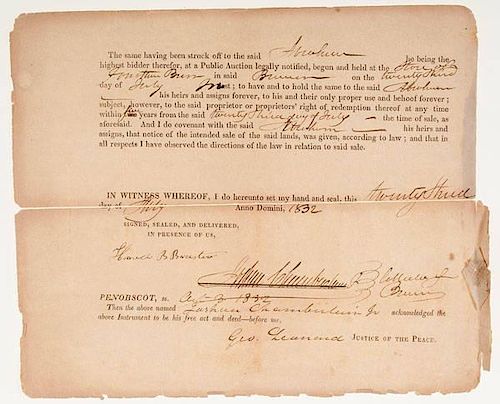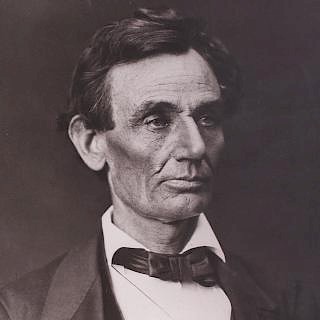Ephemera Related to Brewer, ME, 1800 - 1855, Including Documents Signed by Joshua Chamberlain's Father
About Seller
6270 Este Ave.
Cincinnati , OH 45232
United States
With offices in Cincinnati, Cleveland and Denver, Cowan’s holds over 40 auctions each year, with annual sales exceeding $16M. We reach buyers around the globe, and take pride in our reputation for integrity, customer service and great results. A full-service house, Cowan’s Auctions specializes in Am...Read more
Two ways to bid:
- Leave a max absentee bid and the platform will bid on your behalf up to your maximum bid during the live auction.
- Bid live during the auction and your bids will be submitted real-time to the auctioneer.
Bid Increments
| Price | Bid Increment |
|---|---|
| $0 | $25 |
| $500 | $50 |
| $1,000 | $100 |
| $2,000 | $250 |
| $5,000 | $500 |
| $10,000 | $1,000 |
| $20,000 | $2,500 |
| $50,000 | $5,000 |
| $100,000 | $10,000 |
About Auction
Jul 21, 2014 - Jul 22, 2014
Cowan's Auctions dawnie@cowans.com
- Lot Description
Lot of 90+ items of ephemera, ranging from small 1.5 x 4 in. receipts to full legal sheets. Most are from Brewer (ME), a few from nearby Bangor and Orrington. Most are from the 1830s with a few to 1800 and the latest, 1855. The majority relate to Daniel Brewer, but there are many others from the town with whom he interacted. The items include receipts, account pages (Brewer to Humphreys, Brewer to Parker, etc.), land sales and survey documents. There is only one letter, and unfortunately it is badly rodent chewed, from Horace B. Stone to his brother (probably Samuel B. Stone) in 1839. The items include most activities needed for survival in this “out of the way” part of the young nation. One of the bills is for parts for Brewer’s boat. Another bill is for 6000 bricks ($26.00!), and yet another if a bill for making sleds. There is an appraisal for the S. Kent estate – 4pp listing household belongings from a sofa to different kinds of chairs to a spittoon.
One interesting document is a partially printed form listing a winning bid from an auction held 23 July 1832 in Brewer. It lists Abraham as the highest bidder, but the amount is not given. It is signed by Joshua Chamberlain Jr. (the father of Joshua Chamberlain, b. 1828, Gettysburg MOH winner, four-time governor of Maine, and president of Bowdin College).
Another amusing note is dated Feb. 18, 1840, Brewer. It is to Mr. S.B. Stone from C. Redlow Jr. ”At the last meeting held by the Whigs of this Town for the purpose of organizing, you were chosen one of the class committee for the ensuing year together with Geo. Brewer & myself. If convenient to you we had better have a meeting Saturday to see about calling a convention to nominate Town officers to be supported on the 2nd of March next & to make any other necessary arrangements.” Wow! Picking your candidates two weeks before the election. Don’t we wish….?!
Two documents are related, one grants to Theophilus Nickerson and Samuel B. Stone 1/8 part of a machine “for mortaring and manufacturing window sash and blinds,” (for $750) based on a patent granted to Orin Ellis. Signed by John L. Brewer, 2 Jan. 1836. The other is for the sale of all the machinery and tools in Fisk’s and Stern’s factory for making sash to Nickerson and Stone for $1000, 1 Jan. 1836. Another document records the sale of a shop, “built as a shoemaker’s shop,” opposite the blacksmith’s shop in Brewer to S.B. Stone for $115, by Micah C. Foster.
Among the more interesting documents is one enigmatic receipt for a “Crest of Stone, of Suffolk, England, taken from the Crests of the Gentry, in Knights specimens of crests, in State Library Jan’y. 1851.” S.B. Stone. Another is a partially printed blank apprenticeship document:
________ doth by these presents bind _________ and with the free will and consent of the said _______ is hereby bound an Apprentice to___________ the learn the art, trade or mystery of _________ and with him the said ______ after the manner of an apprentice, to serve from the date of these presents, until the ______ day of ______ which will be in the year of our Lord one thousand eight hundred and _____ when the said apprentice will arrive at the age of______ years. During all which time, the said apprentice his said master well and faithfully shall serve, his secrets keep, his lawful commands duly obey. He shall do no damage to his said master, nor suffer it to be done by others, without giving seasonable notice thereof to his said master – He shall not waste the goods of his said master, nor lend them unlawfully to any – At cards, dice, or any other unlawful game, he shall not play – He shall not absent himself, by day or by night, from the service of his said master without this leave; nor haunt or frequent ale-houses, taverns, or gaming places – He shall not contact matrimony within the said term; nor shall he commit any acts of vice or immorality which are forbidden by the laws of the Commonwealth; but in all things, and at all times, he shall carry and behave himself towards his said master, and all others, as a good and faithful apprentice ought to do, during all the term aforesaid…..
Another of the smaller receipts lists:
one note to D. Brewer Dated April 8, 1835 -----------------$250.00
Interest on same to Feby 8, 1841 -------------------- 87.50
$ 337.50
one note to J. Chamberlain Date & interest ---------- 337.50
$ 675.00
One half-sheet has the wording of an act passed by the town council, and a second which appears to be an act of council: That the Report be recommitted with instructions to report a Resolve, requiring the Superintendent of Public Buildings, to cause the back seats numbered from 109 to 152, to be re??? into the corners of the hall, at the right and left of the Speakers Desk.
Brewer is in Penobscot County, opposite Bangor on the Penobscot River estuary. Today it is part of the Bangor Metro statistical area, and is connected to its sister city by 3 bridges. Orrington incorporated with Brewer in 1788, but Brewer broke away and incorporated as a separate town in 1812, although some still referred to the whole as Orrington, or New Worcester, since the founder, Col. John A. Brewer, was born in Worcester (MA). The Brewer Historical Society’s summary gives Mr. Brewer as an early settler, if not the first, he was the first to be joined by a number of family and friends. They do not, however, give a date for this settlement. They do mention that the settlers were just getting established when the Revolutionary War came along, suggesting the settlement began in the early 1770s.
The only John Brewer (a fairly common name) we find in the area was born to Samuel and Martha Brewer on 7 Aug. 1749 (Massachusetts Town & Vital Records 1620-1988). Although the place of birth is not specified, we find the same John Brewer listed as a native of Worcester marrying Martha Graves of Weston in 1769 (one entry says 1 June, another entry says 9 April – same couple). This would fit with the settlement of Brewer about 1770 or shortly thereafter. At the time, this was still part of Massachusetts. Maine would finally win independence as a state in 1820.
These receipts also reflect the economy of Brewer. The soils in the area are heavy clays, and Brewer became famous for brick-making in the 19th century. Boston, it is said, is built of Brewer bricks and Bangor lumber. Brewer had its own smaller lumber industry, much of it geared toward shipbuilding and making sashes, both reflected in these glimpses of daily life. And ships often took Brewer bricks as ballast, then sold them for additional income. Late in the 19th century, after these bits of ephemera, Brewer would develop a pulp and paper industry in part to make use of the ends /scraps of lumber from the saw-mills. One industry not represented here was ice – cut from the rivers in winter, and stored in sawdust until spring and summer.
Some of the names mentioned in these slips (and the dates associated, if any):
Joseph Avery (1837)
John Brewer (1800)
Jonah Brewer (1834)
Josiah Brewer (1827)
J.L. Brewer (1833)
Daniel Brewer (1825, 1827, 1832, 1833, etc.)
Francis Brewer (1836)
George Brewer (1832, 1834, +)
Caleb Burr
John Chambers (1833)
John Cooper (1832)
Rufus Cuthing (1832)
Elihu Dale (1831, 1839)
Stevens Davis
??? Dutton (1835)
Jeremiah Eldridge (1832)
Micah Foster (1832)
Benjamin Fowls (1845)
Wm. R. Ginn (1827)
John E. Godfrey (1841)
Benjamin Goodwin (1832, 1855)
Abraham Hill
Watson Holbrook
David Homer (or Homes) (1832)
Theophilis Howes (1835)
James Humphreys (1825)
Samuel Lawrence (1831)
William Lowder
Jos. Milliken Jr. (1833)
Theophilus Nickerson (1834)
James B. Parker (1826)
J.L. Parker (1853)
?? Pond (Esq. 1830)
Joseph Sewall (1828, 1829)
C.G. Sterns (1843, 1845)
Samuel B. Stone (1834)
Davos Sumner (1832)
Thomas Treadwell (1831)
David Vickers (1832)
Warren Ware (1834)
Aaron Warren (1832)
Henry Watson (1833)
John Wilkins (1843)
Sewall Williams (1834)
J. Wilson (1836)As expected. Rodent damage to a number of the larger sheets (the little ones escaped their attention).Condition
- Shipping Info
-
SHIPPING. At the request of the buyer, Cowan's will authorize the shipment of purchased items. Shipments usually occur within two weeks after payment has been received. Shipment is generally made via UPS Ground service. Unless buyer gives special instructions, the shipping method shall be at the sole discretion of Cowan's Auctions, Inc.. Cowan's is in no way responsible for the acts or omissions of independent handlers, packers or shippers of purchased items or for any loss, damage or delay from the packing or shipping of any property.
-
- Buyer's Premium



 EUR
EUR CAD
CAD AUD
AUD GBP
GBP MXN
MXN HKD
HKD CNY
CNY MYR
MYR SEK
SEK SGD
SGD CHF
CHF THB
THB





